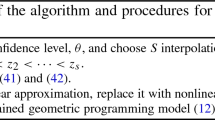Abstract
In this paper, we study 0–1 quadratic programs with joint probabilistic constraints. The row vectors of the constraint matrix are assumed to be normally distributed but are not supposed to be independent. We propose a mixed integer linear reformulation and provide an efficient semidefinite relaxation of the original problem. The dependence of the random vectors is handled by the means of copulas. Finally, numerical experiments are conducted to show the strength of our approach.
Similar content being viewed by others
References
Beasley, J.B.: OR-Library (2012). http://people.brunel.ac.uk/mastjjb/jeb/info.html
Boyd, S.P., Vandenberghe, L.: Applications of semidefinite programming. App. Numer. Math. 29, 283–299 (1999)
Boyd, S.P., Vandenberghe, L.: Convex Optimization. Cambridge University Press, Cambfidge (2004). Seventh printing with corrections, 2009
Burer, S.: On the copositive representation of binary and continuous nonconvex quadratic programs. Math. Program. 120(2), 479–495 (2009). doi:10.1007/s10107-008-0223-z
Charnes, A., Cooper, W.W., Symonds, G.H.: Cost horizons and certainty equivalents: an approach to stochastic programming of heating oil. Manage. Sci. 4(3), 235–263 (1958)
Cheng, J., Gicquel, C., Lisser, A.: A second-order cone programming approximation to joint chance-constrained linear programs. In: Mahjoub A., Markakis V., Milis I., Paschos V. (eds.) Combinatorial Optimization, Lecture Notes in Computer Science, vol. 7422, pp. 71–80. Springer, Berlin/Heidelberg (2012). doi:10.1007/978-3-642-32147-4_8
Cheng, J., Lisser, A.: A second-order cone programming approach for linear programs with joint probabilistic constraints. Operat. Res. Lett. 40(5), 325–328 (2012). doi:10.1016/j.orl.2012.06.008
Cheng, J., Lisser, A.: A completely positive representation of 0–1 linear programs with joint probabilistic constraints. Operat. Res. Lett. 41(6), 597–601 (2013). doi:10.1016/j.orl.2013.08.008
Dentcheva, D.: Optimization models with probabilistic constraints. In: Shapiro, A., Dentcheva, D., Ruszczyński, A. (eds.) Lectures on Stochastic Programming: Modeling and Theory, MOS-SIAM Series on Optimization, vol. 9, pp. 87–153. SIAM, Philadelphia (2009)
Fortet, R.: Applications de l’algebre de boole en recherche operationelle. Revue Francaise de Recherche Operationelle 4, 17–26 (1960)
Goemans, M., Williamson, D.: Improved approximation algorithms for maximum cut and satisfiability problems using semidefinite programming. J. ACM 42(6), 1115–1145 (1995)
Henrion, R., Strugarek, C.: Convexity of chance constraints with dependent random variables: the use of copulae. In: Bertocchi M., Consigli G., Dempster M.A.H. (eds.) Stochastic Optimization Methods in Finance and Energy, International Series in Operations Research and Management Science, vol. 163, pp. 427–439. Springer, New York (2011). doi:10.1007/978-1-4419-9586-5_17
IBM: IBM ILOG CPLEX Optimizer. http://www.ibm.com/software/integration/optimization/cplex/
László, L.: On the shannon capacity of a graph. IEEE Trans. Inf. Theory 25(1), 1–7 (1979)
Nelsen, R.B.: An Introduction to Copulas, 2nd edn. Springer, New York (2006)
Parillo, P.A.: Structured semidefinite programs and semialgebraic geometry methods in robustness and optimization. Ph.D. thesis, California Institute of Technology (2000)
Prékopa, A.: Stochastic Programming. Akadémiai Kiadó, Budapest (1995)
Prékopa, A.: Probabilistic programming. In: Ruszczyński, A., Shapiro, A. (eds.) Stochastic Programming, Handbooks in Operations Research and Management Science, vol. 10, pp. 267–352. Elsevier, Amsterdam (2003)
Singh V. Jain S., T.A.: Risk and reliability analysis: a handbook for civil and environmental engineers, vol. 1. ASCE (2007)
Sturm, J.F.: Using SeDuMi 1.02, a Matlab toolbox for optimization over symmetric cones. Optim. Methods Softw. 11–12, 625–653 (1999)
Thakur, L.S.: Error analysis for convex separable programs: the piecewise linear approximation and the bounds on the optimal objective value. SIAM J. Appl. Math. 34(4), 704–714 (1978). doi:10.1137/0134059
Zhang, L.: S.V.: Gumbel-Hougaard copula for trivariate rainfall frequency analysis. J. Hydrol. Eng. 12(4), 409–419 (2007)
Acknowledgments
This research was supported by Fondation Mathématiques Jacques Hadamard, PGMO/IROE grant No. 2012-042H.
Author information
Authors and Affiliations
Corresponding author
Rights and permissions
About this article
Cite this article
Cheng, J., Houda, M. & Lisser, A. Chance constrained 0–1 quadratic programs using copulas. Optim Lett 9, 1283–1295 (2015). https://doi.org/10.1007/s11590-015-0854-y
Received:
Accepted:
Published:
Issue Date:
DOI: https://doi.org/10.1007/s11590-015-0854-y




